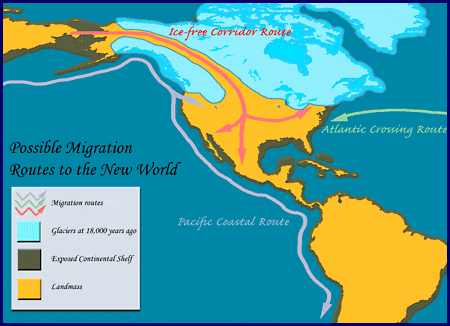- Home
- >
- Preservation Archaeology Blog
- >
- Routes to the New World

Recently, I was a guest on the Scott Michlin Morning Program at KSJE, the San Juan College radio station in Farmington, New Mexico, where I discussed recent findings regarding migrations to the New World. (Listen to the broadcast here.) The researchers used mitochondrial DNA to assess genetic relationships among modern Native American people, and added their results to a substantial database compiled through previous work. (Read an abstract of the study, published in the Proceedings of the National Academy of Sciences, here.)
This new research reveals evidence for three distinct migratory events:
1) 15–18,000 years ago, probably via a Pacific coastal route
2) 12–14,000 years ago, via the long-described ice-free corridor
3) 4,000 years ago, with groups moving eastward across Canada

These new data mesh well with archaeological findings from the last two decades, which have chipped away at the “Clovis first” hypothesis. For decades, North American archaeologists have believed that the Clovis culture or horizon provided the first evidence for the presence of humans in the New World. This view holds that there is no good evidence prior to about 13,400 years ago.
However, several sites in North America have now been securely dated to pre-Clovis times. One such site is Paisley Cave in Oregon. The site has projectile points and other stone tools distinct from Clovis styles, as well as human coprolites (poop!) that has been radiocarbon dated to the interval from 13,000—14,340 years ago. DNA evidence from the site indicates a relationship to people in Asia. The Buttermilk Creek site in Texas also has convincing proof of pre-Clovis people. The site is dated between 13,500 and 15,500 BP (before present) and has a large collection of lithic tools and debris.
Another pre-Clovis site lies in South America, in Chile. Monte Verde is radiocarbon dated to 14,600 BP. The site contains the remains of a large tent-like structure constructed of wooden poles and animal hides. Artifacts from the site include many stone tools and seeds, nuts, and berries.
The genetic researchers noted that as additional DNA samples are studied and added to the database, it is possible that additional migration events may be identified—so, stay tuned!
To read an abstract of the article, click here.
3 thoughts on “Routes to the New World”
Comments are closed.
Explore the News
-
Join Today
Keep up with the latest discoveries in southwestern archaeology. Join today, and receive Archaeology Southwest Magazine, among other member benefits.
So, where is the diagnostic artifact assemblage of the so-called preClovis? I have worked at Gault and found convincing evidence that there is NO pre-Clovis; Buttermilk is just an extension of the Gault terrace and I have seen the assemblage from that site. The luminescent dates are older than the non-diagnostic artifacts (which could be either Clovis or Archaic). I don’t buy Monte Verde (where is the chipped stone debitage? It is a Late Paleo peat bog with preserved hunting (nets, stakes) tools. Sure the peat will date older than the artifacts. Paisely, Meadowcroft? There is NO identifiable diagnostic artifact assemblage until Clovis. If so, show me.
Harry:
Thanks for the comment. I encourage you to contact the archaeologists who have studied the pre-Clovis sites directly.
Obviously Harry did not attend the recent Paleoamerican Odyssey conference in Santa Fe, or read the almost-600 page volume of its proc endings. See: http://paleoamericanodyssey.com
KP